Mitigation of Membrane Fouling in Membrane Bioreactors Using Granular and Powdered Activated Carbon: An Experimental Study
Abstract
1. Introduction
2. Materials and Methods
2.1. Membrane Bioreactor
2.2. Experimental Configurations
2.3. Analytical Methods
2.4. Fouling Evaluation
2.4.1. Critical Flux Determination
2.4.2. Membrane Fouling Resistance Analysis
3. Results
3.1. Determination of Critical Flux
3.1.1. Analysis of TMP Changes with Varying MLSS Concentrations and Activated Carbon Dosages
3.1.2. Fouling Rate and Flux Evaluation
3.1.3. Initial Increase in TMP
3.2. Membrane Fouling Resistance Analysis
3.3. Permeate Water Quality
4. Conclusions
Author Contributions
Funding
Data Availability Statement
Acknowledgments
Conflicts of Interest
References
- Zhao, Y.; Qiu, Y.; Mamrol, N.; Ren, L.; Li, X.; Shao, J.; Yang, X.; van der Bruggen, B. Membrane bioreactors for hospital wastewater treatment: Recent advancements in membranes and processes. Front. Chem. Sci. Eng. 2022, 16, 634–660. [Google Scholar] [CrossRef]
- Qrenawi, L.I.; Rabah, F.K. Membrane Bioreactor (MBR) as a Reliable Technology for Wastewater Treatment. J. Membr. Sci. Res. 2023, 9, 548826. [Google Scholar] [CrossRef]
- Rahman, T.U.; Roy, H.; Islam, R.; Tahmid, M.; Fariha, A.; Mazumder, A.; Tasnim, N.; Pervez, N.; Cai, Y.; Naddeo, V.; et al. The advancement in membrane bioreactor (MBR) technology toward sustainable industrial wastewater management. Membranes 2023, 13, 181. [Google Scholar] [CrossRef]
- Judd, S. The status of industrial and municipal effluent treatment with membrane bioreactor technology. Chem. Eng. J. 2016, 305, 37–45. [Google Scholar] [CrossRef]
- Torre, A.; Vázquez-Rowe, I.; Parodi, E.; Kahhat, R. A multi-criteria decision framework for circular wastewater systems in emerging megacities of the Global South. Sci. Total. Environ. 2024, 912, 169085. [Google Scholar] [CrossRef] [PubMed]
- Judd, S. The MBR Book: Principles and Applications of Membrane Bioreactors for Water and Wastewater Treatment; Butterworth-Heinemann: Oxford, UK, 2010. [Google Scholar]
- Iorhemen, O.T.; Hamza, R.A.; Tay, J.H. Membrane fouling control in membrane bioreactors (MBRs) using granular materials. Bioresour. Technol. 2017, 240, 9–24. [Google Scholar] [CrossRef]
- Oghyanous, F.A.; Etemadi, H.; Yegani, R.; Ghofrani, B. Membrane fouling and removal performance of submerged aerobic membrane bioreactors: A comparative study of optimizing operational conditions and membrane modification. J. Chem. Technol. Biotechnol. 2022, 97, 1190–1199. [Google Scholar] [CrossRef]
- Wang, Z.; Zeng, J.; Shi, Y.; Ling, G. MBR membrane fouling diagnosis based on improved residual neural network. J. Environ. Chem. Eng. 2023, 11, 109742. [Google Scholar] [CrossRef]
- Zamora, R.; McEvoy, J.; Colbert, C.; Olivares, J.C.; Kaewlom, P.; Khan, E. Blocking bacterial appendage attachment to wastewater treatment membranes using anti-adhesins. Chemosphere 2023, 323, 138246. [Google Scholar] [CrossRef]
- Nguyen, P.-T.; Tran, D.P.H.; Le, L.-T.; Lin, C.; Oanh, L.T.K.; Tra, V.-T.; Bui, X.-T. Characterization of reciprocation membrane bioreactor on treatment performance, energy consumption and membrane fouling. Bioresour. Technol. 2023, 381, 129146. [Google Scholar] [CrossRef] [PubMed]
- Liu, Q.; Ren, J.; Lu, Y.; Zhang, X.; Roddick, F.A.; Fan, L.; Wang, Y.; Yu, H.; Yao, P. A review of the current in-situ fouling control strategies in MBR: Biological versus physicochemical. J. Ind. Eng. Chem. 2021, 98, 42–59. [Google Scholar] [CrossRef]
- Wang, S.; Chew, J.W.; Liu, Y. An environmentally sustainable approach for online chemical cleaning of MBR with activated peroxymonosulfate. J. Membr. Sci. 2020, 600, 117872. [Google Scholar] [CrossRef]
- Bertino, A.; Falasconi, M.B.; Mazzeo, L.; Piemonte, V. Membranes for the Water Biotreatment, in Current Trends and Future Developments on (Bio-) Membranes; Elsevier: Amsterdam, The Netherlands, 2024; pp. 549–604. [Google Scholar] [CrossRef]
- Wang, Z.; Ma, J.; Tang, C.Y.; Kimura, K.; Wang, Q.; Han, X. Membrane cleaning in membrane bioreactors: A review. J. Membr. Sci. 2014, 468, 276–307. [Google Scholar] [CrossRef]
- Asif, M.B.; Ren, B.; Li, C.; He, K.; Zhang, X.; Zhang, Z. Understanding the role of in-situ ozonation in Fe(II)-dosed membrane bioreactor (MBR) for membrane fouling mitigation. J. Membr. Sci. 2021, 633, 119400. [Google Scholar] [CrossRef]
- Maddela, N.R.; Abiodun, A.S.; Zhang, S.; Prasad, R. Biofouling in membrane bioreactors—Mitigation and current status: A review. Appl. Biochem. Biotechnol. 2023, 195, 5643–5668. [Google Scholar] [CrossRef]
- Behboudi, A.; Mohammadi, T.; Ulbricht, M. High performance antibiofouling hollow fiber polyethersulfone nanocomposite membranes incorporated with novel surface-modified silver nanoparticles suitable for membrane bioreactor application. J. Ind. Eng. Chem. 2023, 119, 298–314. [Google Scholar] [CrossRef]
- Chen, Y.; Sheng, Q.; Wei, J.; Wen, Q.; Ma, D.; Li, J.; Xie, Y.; Shen, J.; Sun, X. Novel strategy for membrane biofouling control in MBR with nano-MnO2 modified PVDF membrane by in-situ ozonation. Sci. Total. Environ. 2022, 808, 151996. [Google Scholar] [CrossRef]
- Frontistis, Z.; Sarmpanis, A.; Lykogiannis, G. Utilizing ultrasonic vibrations to mitigate membrane fouling in domestic wastewater membrane bioreactors: A mini review. J. Chem. Technol. Biotechnol. 2023, 98, 2798–2805. [Google Scholar] [CrossRef]
- Syafiuddin, A.; Boopathy, R.; Mehmood, M.A. Recent advances on bacterial quorum quenching as an effective strategy to control biofouling in membrane bioreactors. Bioresour. Technol. Rep. 2021, 15, 100745. [Google Scholar] [CrossRef]
- Zhang, R.; Hao, L.; Cheng, K.; Xin, B.; Sun, J.; Guo, J. Research progress of electrically-enhanced membrane bioreactor (EMBR) in pollutants removal and membrane fouling alleviation. Chemosphere 2023, 331, 138791. [Google Scholar] [CrossRef]
- Wang, S.; Zhang, Y.; Han, Y.; Hou, Y.; Fan, Y.; Hou, X. Design of Porous Membranes by Liquid Gating Technology. Accounts Mater. Res. 2021, 2, 407–419. [Google Scholar] [CrossRef]
- Xu, L.; Wei, C.; Siddique, M.S.; Yu, W. Insight into the effect of in-situ galvanic micro-coagulation on membrane fouling mitigation treating surface water. J. Membr. Sci. 2020, 610, 118234. [Google Scholar] [CrossRef]
- Esteki, S.; Karsaz, M.; Ghofrani, B.; Yegani, R.; Majidi, S. Combination of membrane bioreactor with chemical coagulation for the treatment of real pharmaceutical wastewater: Comparison of simultaneous and consecutive pre-treatment of coagulation on MBR performance. J. Water Process. Eng. 2024, 60, 105108. [Google Scholar] [CrossRef]
- Yang, Y.; Guo, W.; Ngo, H.H.; Zhang, X.; Liang, S.; Deng, L.; Cheng, D.; Zhang, H. Bioflocculants in anaerobic membrane bioreactors: A review on membrane fouling mitigation strategies. Chem. Eng. J. 2024, 486, 150260. [Google Scholar] [CrossRef]
- Yang, Y.; Guo, W.; Ngo, H.H.; Zhang, X.; Ye, Y.; Peng, L.; Wei, C.; Zhang, H. Mini critical review: Membrane fouling control in membrane bioreactors by microalgae. Bioresour. Technol. 2024, 406, 131022. [Google Scholar] [CrossRef] [PubMed]
- Gkotsis, P.; Zouboulis, A.; Mitrakas, M. Using additives for fouling control in a lab-scale MBR; comparing the anti-fouling potential of coagulants, PAC and bio-film carriers. Membranes 2020, 10, 42. [Google Scholar] [CrossRef] [PubMed]
- Asif, M.B.; Ren, B.; Li, C.; Maqbool, T.; Zhang, X.; Zhang, Z. Evaluating the impacts of a high concentration of powdered activated carbon in a ceramic membrane bioreactor: Mixed liquor properties, hydraulic performance and fouling mechanism. J. Membr. Sci. 2020, 616, 118561. [Google Scholar] [CrossRef]
- Zhang, Y.; Wang, X.; Ye, H.; Zhou, L.; Zhao, Z. Effect and mechanism of reduced membrane bioreactor fouling by powdered activated carbon. Water Sci. Technol. 2021, 83, 1005–1016. [Google Scholar] [CrossRef]
- Gkotsis, P.K.; Banti, D.C.; Peleka, E.N.; Zouboulis, A.I.; Samaras, P.E. Fouling issues in membrane bioreactors (MBRs) for wastewater treatment: Major mechanisms, prevention and control strategies. Processes 2014, 2, 795–866. [Google Scholar] [CrossRef]
- Yu, S.; Wang, J.; Zhao, Z.; Cai, W. Simultaneous coupling of fluidized granular activated carbon (GAC) and powdered activated carbon (PAC) with ultrafiltration process: A promising synergistic alternative for water treatment. Sep. Purif. Technol. 2022, 282, 120085. [Google Scholar] [CrossRef]
- Liu, Y.; Cui, X.; Zhang, X.; Ren, J.; Li, H.; Wang, Z.; Guo, W.; Ngo, H.H. Recent advances and trends of carbon-based biocarriers for performance enhancement of anaerobic membrane bioreactor system. J. Water Process. Eng. 2024, 59, 104949. [Google Scholar] [CrossRef]
- Johir, M.; Shanmuganathan, S.; Vigneswaran, S.; Kandasamy, J. Performance of submerged membrane bioreactor (SMBR) with and without the addition of the different particle sizes of GAC as suspended medium. Bioresour. Technol. 2013, 141, 13–18. [Google Scholar] [CrossRef]
- Wu, B.; Zamani, F.; Lim, W.; Liao, D.; Wang, Y.; Liu, Y.; Chew, J.W.; Fane, A.G. Effect of mechanical scouring by granular activated carbon (GAC) on membrane fouling mitigation. Desalination 2017, 403, 80–87. [Google Scholar] [CrossRef]
- Aslam, M.; Kim, J. Investigating membrane fouling associated with GAC fluidization on membrane with effluent from anaerobic fluidized bed bioreactor in domestic wastewater treatment. Environ. Sci. Pollut. Res. 2019, 26, 1170–1180. [Google Scholar] [CrossRef]
- Sohn, W.; Guo, W.; Ngo, H.H.; Deng, L.; Cheng, D.; Zhang, X. A review on membrane fouling control in anaerobic membrane bioreactors by adding performance enhancers. J. Water Process. Eng. 2021, 40, 101867. [Google Scholar] [CrossRef]
- APHA; AWWA; WEF. Standard Methods for the Examination of Water and Wastewater, 22nd ed.; American Public Health Association, American Water Works Association, and Water Environment Federation: Washington, DC, USA, 2012. [Google Scholar]
- Le Clech, P.; Jefferson, B.; Chang, I.S.; Judd, S.J. Critical flux determination by the flux-step method in a submerged membrane bioreactor. J. Membr. Sci. 2003, 227, 81–93. [Google Scholar] [CrossRef]
- Yang, W.; Paetkau, M.; Cicek, N. Improving the performance of membrane bioreactors by powdered activated carbon dosing with cost considerations. Water Sci. Technol. 2010, 62, 172–179. [Google Scholar] [CrossRef]
- Choo, K.-H.; Lee, C.-H. Membrane fouling mechanisms in the membrane-coupled anaerobic bioreactor. Water Res. 1996, 30, 1771–1780. [Google Scholar] [CrossRef]
- Jiang, Y.; Liu, Y.; Shi, D.; Fu, W.; Sun, P.-F.; Li, J.; Shao, S. Membrane fouling in a powdered activated carbon—membrane bioreactor (PAC-MBR) for micro-polluted water purification: Fouling characteristics and the roles of PAC. J. Clean. Prod. 2020, 277, 122341. [Google Scholar] [CrossRef]
- Heo, S.; Nam, K.; Woo, T.; Yoo, C. Digitally-transformed early-warning protocol for membrane cleaning based on a fouling-cumulative sum chart: Application to a full-scale MBR plant. J. Membr. Sci. 2022, 643, 120080. [Google Scholar] [CrossRef]
- Du, X.; Shi, Y.; Jegatheesan, V.; Haq, I.U. A Review on the mechanism, impacts and control methods of membrane fouling in MBR system. Membranes 2020, 10, 24. [Google Scholar] [CrossRef] [PubMed]
- Nabi, M.; Liang, H.; Zhou, Q.; Cao, J.; Gao, D. In-situ membrane fouling control and performance improvement by adding materials in anaerobic membrane bioreactor: A review. Sci. Total. Environ. 2023, 865, 161262. [Google Scholar] [CrossRef] [PubMed]
- Shao, S.; Cai, L.; Li, K.; Li, J.; Du, X.; Li, G.; Liang, H. Deposition of powdered activated carbon (PAC) on ultrafiltration (UF) membrane surface: Influencing factors and mechanisms. J. Membr. Sci. 2017, 530, 104–111. [Google Scholar] [CrossRef]
- Huang, X.; Wu, J. Improvement of membrane filterability of the mixed liquor in a membrane bioreactor by ozonation. J. Membr. Sci. 2008, 318, 210–216. [Google Scholar] [CrossRef]
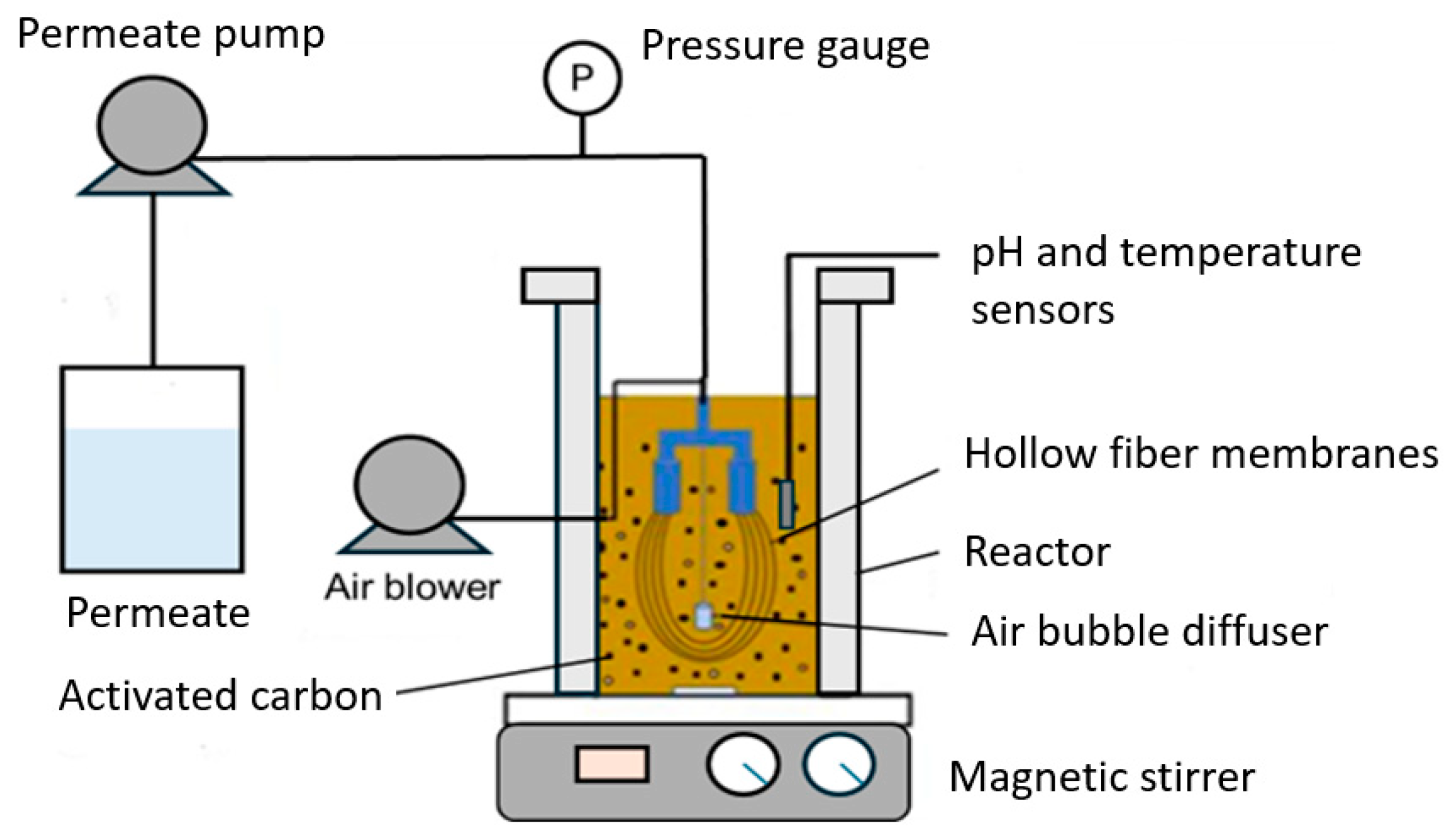
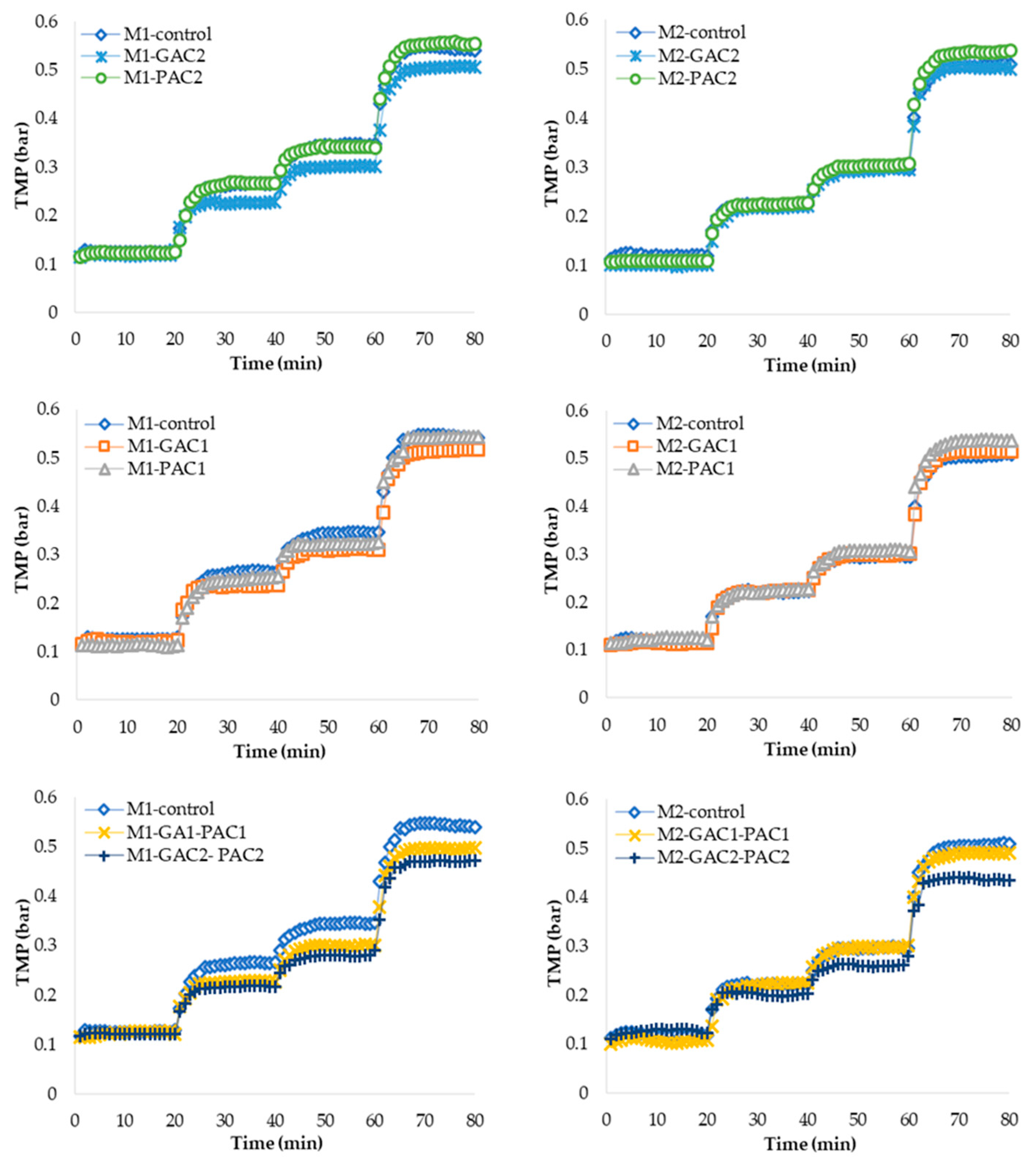
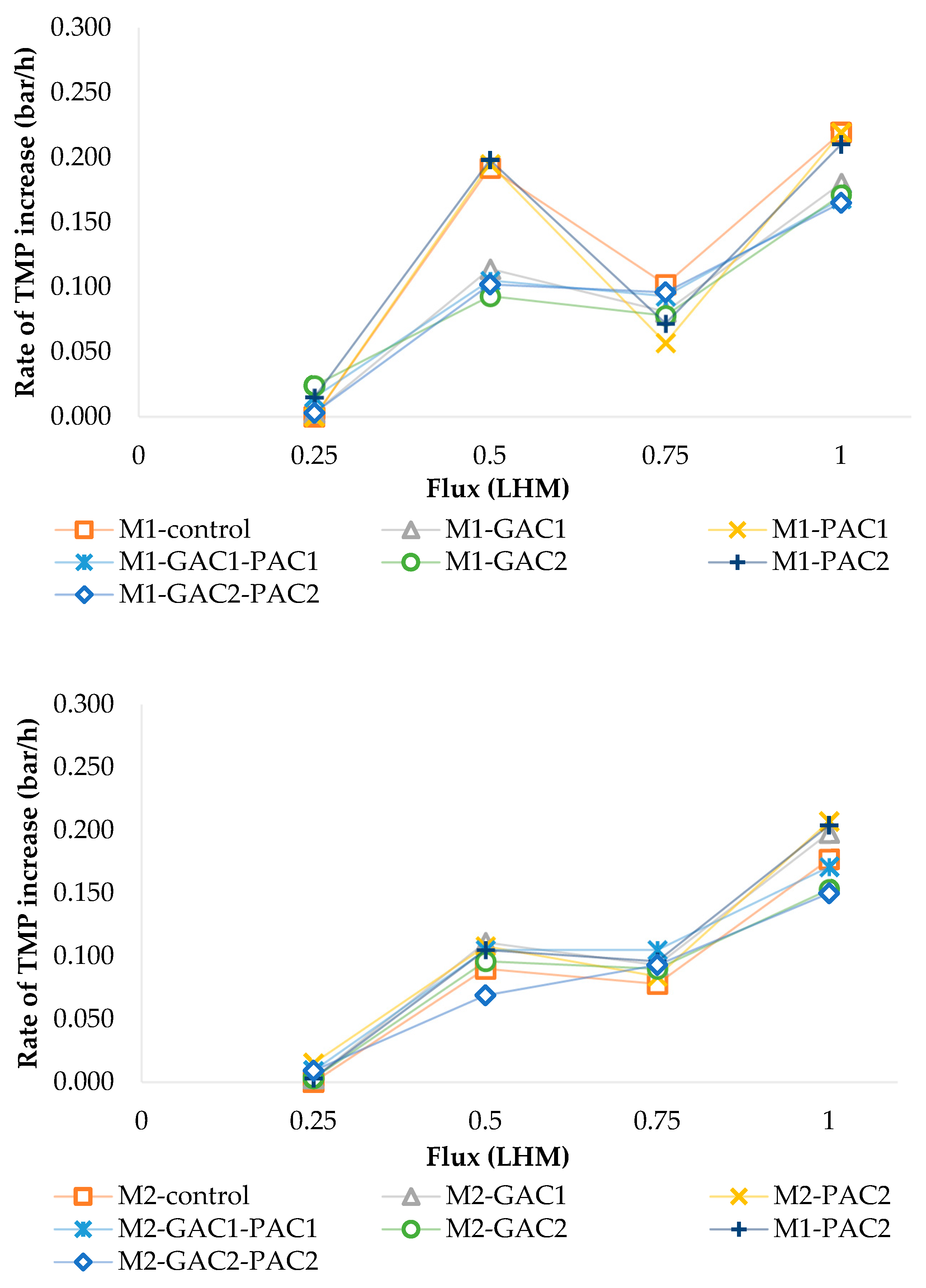

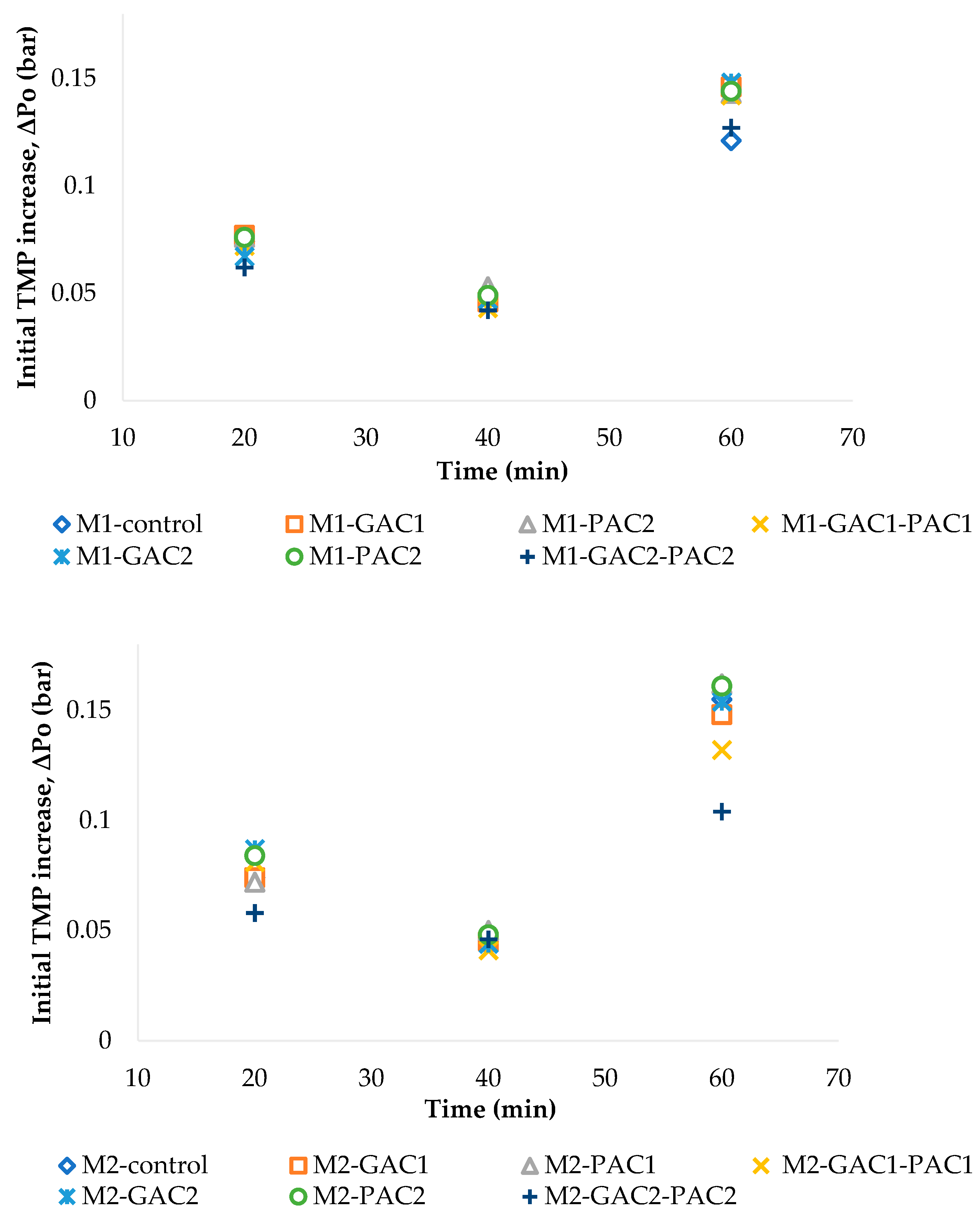
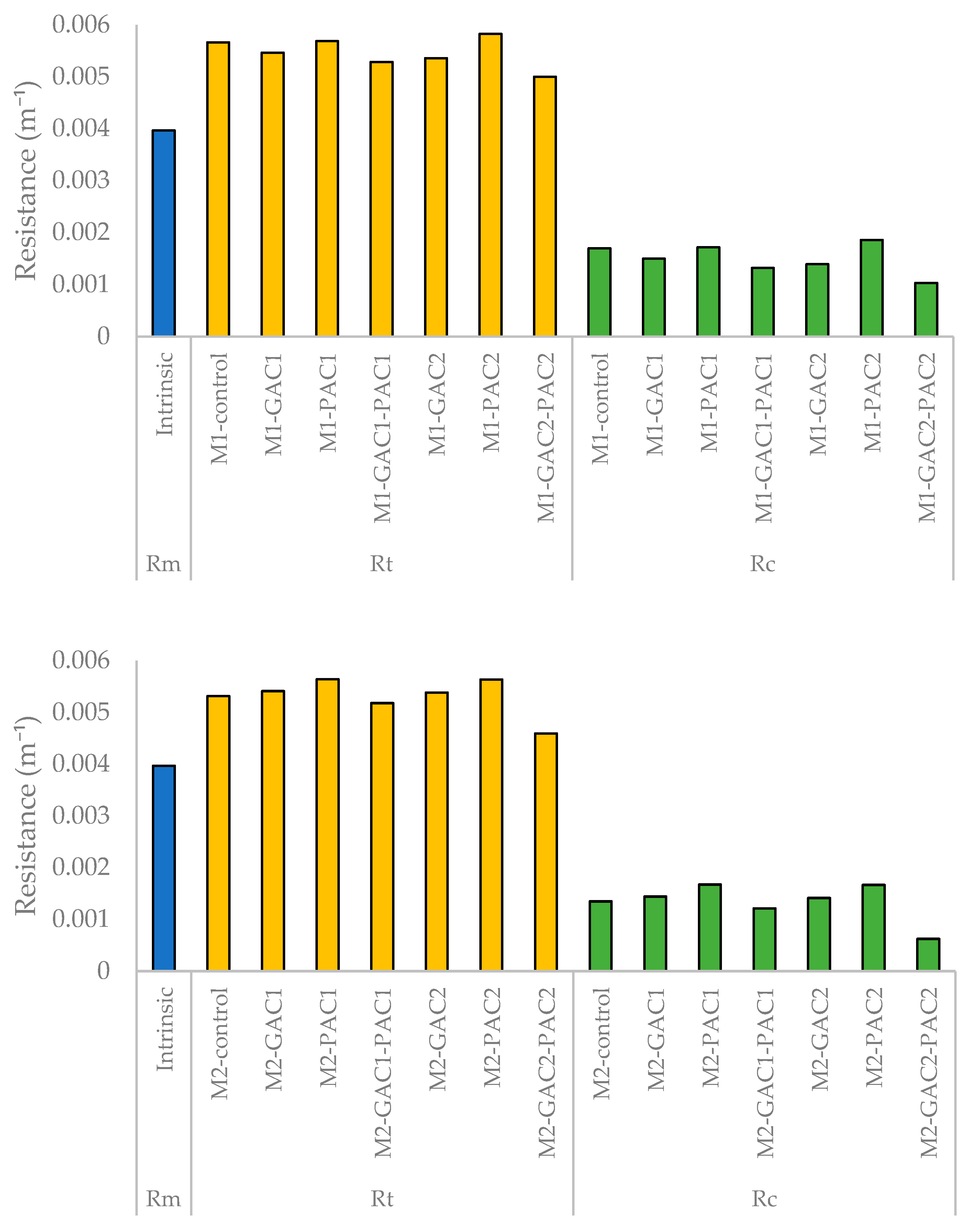
| ID | MLSS | PAC | GAC |
|---|---|---|---|
| g/L | mg/L | g/L | |
| M1 | 3.40 | 0 | 0 |
| M1-GAC 1 | 3.40 | 0 | 2 |
| M1-PAC 1 | 3.40 | 150 | 0 |
| M1-GAC-PAC 1 | 3.40 | 2 | 150 |
| M1-GAC 2 | 3.40 | 0 | 4 |
| M1-PAC 2 | 3.40 | 300 | 0 |
| M1-GAC-PAC 2 | 3.40 | 4 | 300 |
| M2 | 1.15 | 0 | 0 |
| M2-GAC 1 | 1.15 | 0 | 2 |
| M2-PAC 1 | 1.15 | 150 | 0 |
| M2-GAC-PAC 1 | 1.15 | 2 | 150 |
| M2-GAC 2 | 1.15 | 0 | 4 |
| M2-PAC 2 | 1.15 | 300 | 0 |
| M2-GAC-PAC 2 | 1.15 | 4 | 300 |
| ID | Removal (%) | |||
|---|---|---|---|---|
| COD | TN | TP | Turbidity | |
| M1 | 98.85 | 99.13 | 91.72 | 99.95 |
| M1-GAC 1 | 99.15 | 99.47 | 97.85 | 99.96 |
| M1-PAC 1 | 99.29 | 99.47 | 97.55 | 99.98 |
| M1-GAC-PAC 1 | 99.32 | 99.73 | 98.77 | 99.98 |
| M1-GAC 2 | 99.29 | 99.67 | 98.77 | 99.96 |
| M1-PAC 2 | 99.34 | 99.73 | 98.77 | 99.99 |
| M1-GAC-PAC 2 | 99.43 | 99.80 | 99.08 | 99.97 |
| M2 | 98.30 | 99.13 | 98.77 | 99.96 |
| M2-GAC 1 | 98.95 | 98.47 | 99.97 | 99.96 |
| M2-PAC 1 | 98.95 | 99.98 | 99.98 | 99.96 |
| M2-GAC-PAC 1 | 99.54 | 99.99 | 99.97 | 99.99 |
| M2-GAC 2 | 98.95 | 99.99 | 96.26 | 99.96 |
| M2-PAC 2 | 99.08 | 99.88 | 99.97 | 99.97 |
| M2-GAC-PAC 2 | 99.67 | 99.99 | 99.97 | 99.99 |
Disclaimer/Publisher’s Note: The statements, opinions and data contained in all publications are solely those of the individual author(s) and contributor(s) and not of MDPI and/or the editor(s). MDPI and/or the editor(s) disclaim responsibility for any injury to people or property resulting from any ideas, methods, instructions or products referred to in the content. |
© 2024 by the authors. Licensee MDPI, Basel, Switzerland. This article is an open access article distributed under the terms and conditions of the Creative Commons Attribution (CC BY) license (https://creativecommons.org/licenses/by/4.0/).
Share and Cite
Morales, N.; Mery-Araya, C.; Guerra, P.; Poblete, R.; Chacana-Olivares, J. Mitigation of Membrane Fouling in Membrane Bioreactors Using Granular and Powdered Activated Carbon: An Experimental Study. Water 2024, 16, 2556. https://doi.org/10.3390/w16172556
Morales N, Mery-Araya C, Guerra P, Poblete R, Chacana-Olivares J. Mitigation of Membrane Fouling in Membrane Bioreactors Using Granular and Powdered Activated Carbon: An Experimental Study. Water. 2024; 16(17):2556. https://doi.org/10.3390/w16172556
Chicago/Turabian StyleMorales, Nataly, Camila Mery-Araya, Paula Guerra, Rodrigo Poblete, and Jaime Chacana-Olivares. 2024. "Mitigation of Membrane Fouling in Membrane Bioreactors Using Granular and Powdered Activated Carbon: An Experimental Study" Water 16, no. 17: 2556. https://doi.org/10.3390/w16172556
APA StyleMorales, N., Mery-Araya, C., Guerra, P., Poblete, R., & Chacana-Olivares, J. (2024). Mitigation of Membrane Fouling in Membrane Bioreactors Using Granular and Powdered Activated Carbon: An Experimental Study. Water, 16(17), 2556. https://doi.org/10.3390/w16172556








